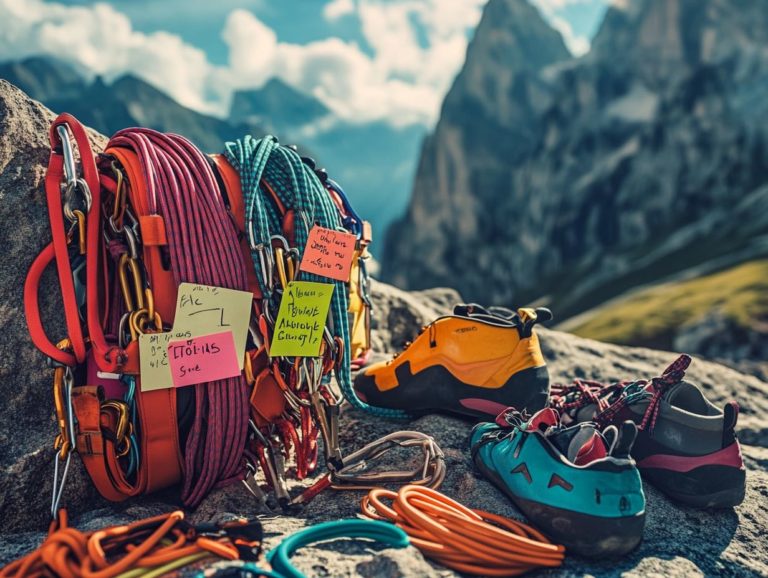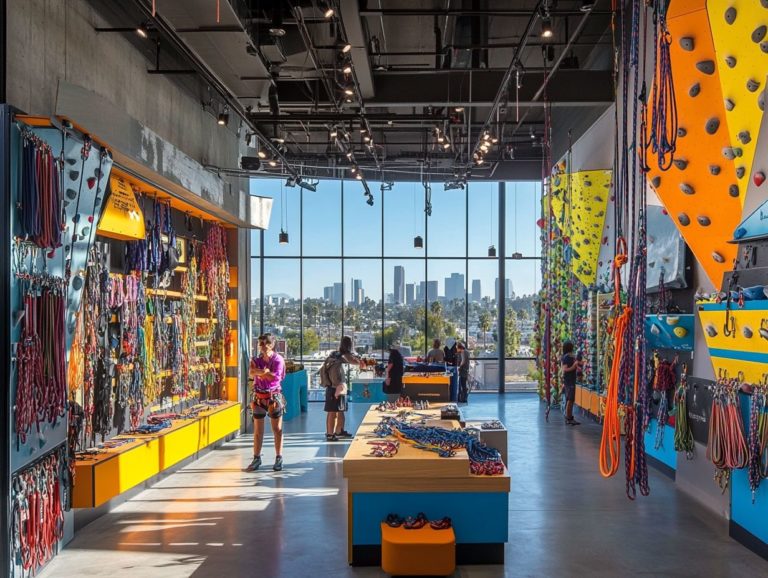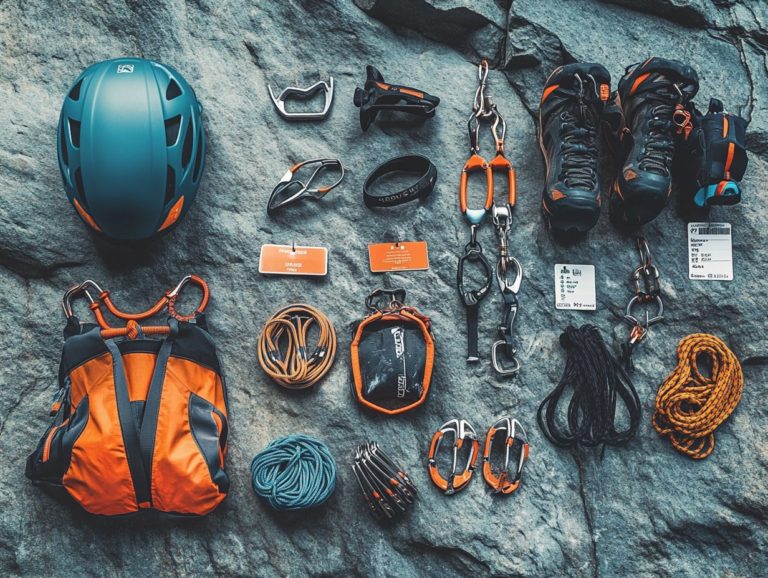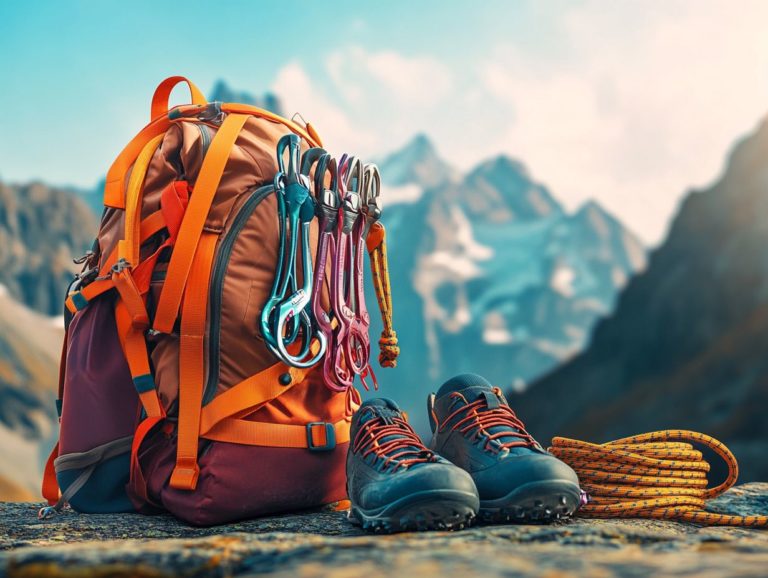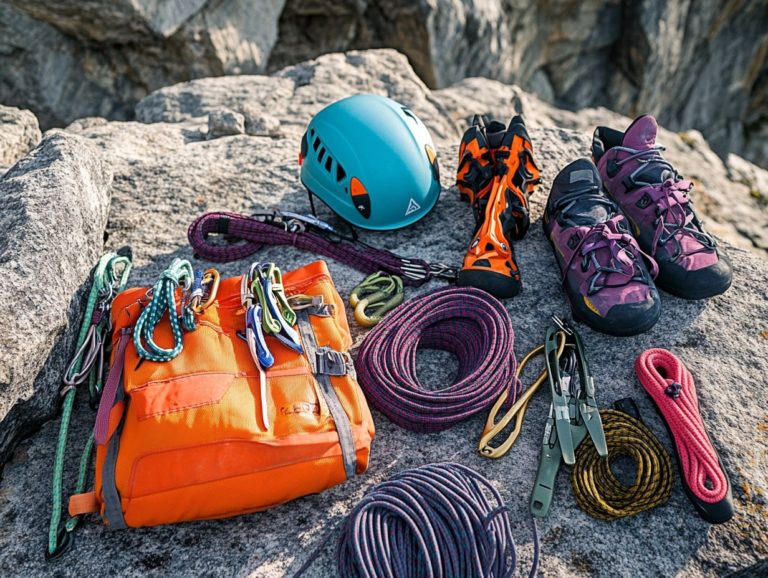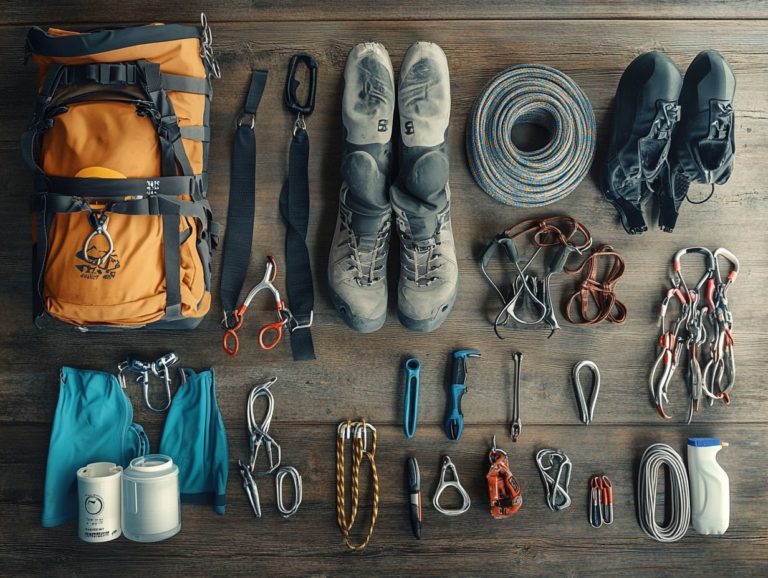The History of Climbing Equipment
Climbing is an ancient pursuit, intricately woven into the fabric of human exploration and adventure.
Consider the evolution of climbing equipment, which has transitioned from simple tools to advanced gear. This change reflects significant advancements in design and safety, particularly in new climbing tools and protection systems.
In this journey, you will explore the history of climbing gear. You ll examine its early versions, modern innovations, and potential future developments. Discover how these tools have greatly influenced the sport, enhancing both performance and safety for climbers.
Contents
- Key Takeaways:
- What is Climbing Equipment?
- Early Forms of Climbing Equipment
- Evolution of Climbing Equipment
- Modern Climbing Equipment
- Notable Climbing Equipment Innovations
- Future of Climbing Equipment
- Frequently Asked Questions
- What is the history of climbing equipment?
- When did climbing equipment start to evolve?
- What role did World War II play in the development of climbing equipment?
- What were some key advancements in climbing equipment during the 1950s and 1960s?
- How did the sport of climbing impact the development of equipment?
- What are some notable improvements in climbing equipment in recent years?
Key Takeaways:
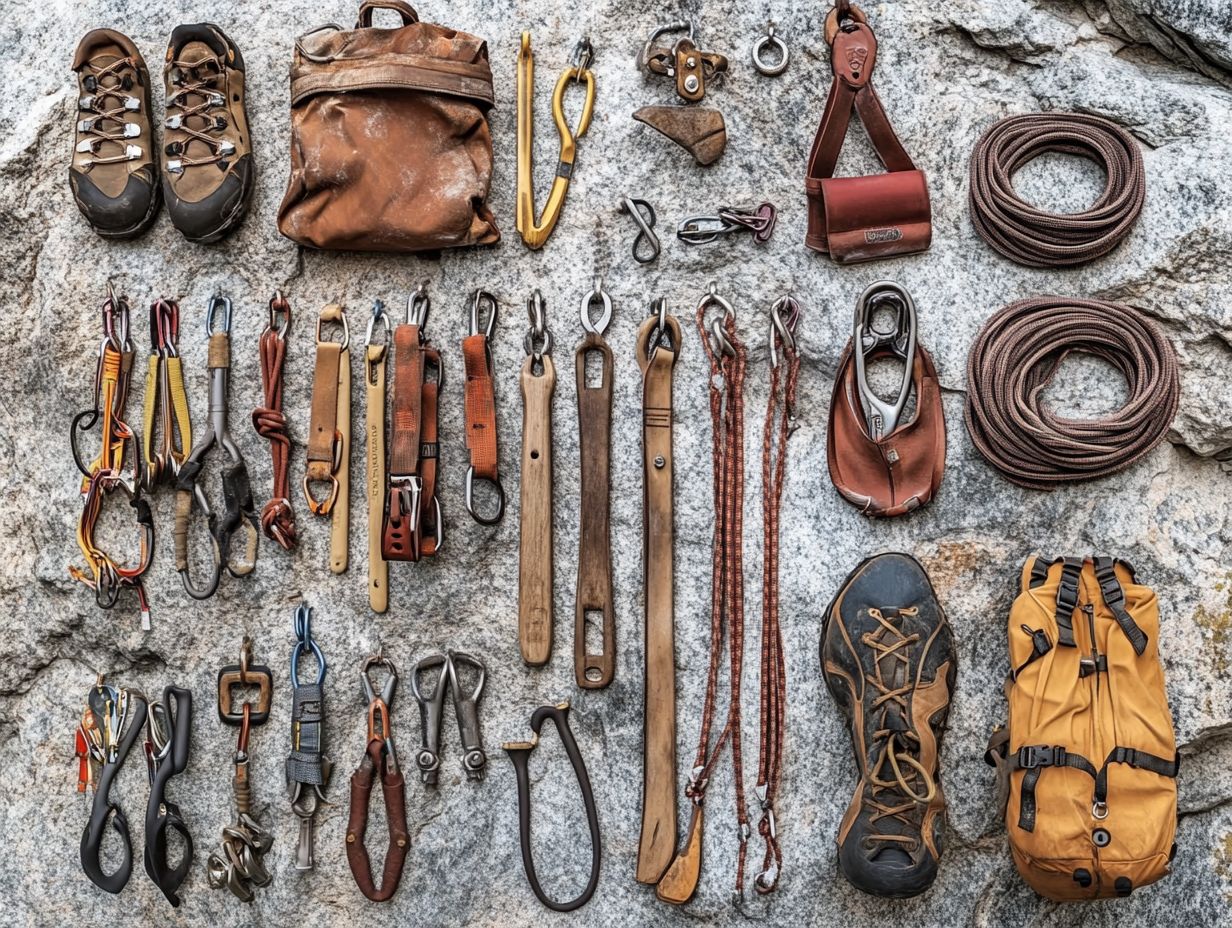
- Climbing gear evolved from simple tools to advanced, specialized equipment.
- Design and technology advancements have improved the safety and efficiency of modern climbing gear.
- Innovations in climbing equipment have revolutionized the sport and continue to shape its future.
What is Climbing Equipment?
Climbing equipment includes various tools and accessories, all crafted to boost your climbing performance while ensuring your safety. This specialized gear features essentials like climbing shoes, safety harnesses, and different protection mechanisms, each evolving remarkably over time.
Today s climbing gear is crafted with advanced materials and smart designs, making your climbing experience safer and more enjoyable. Whether you re a novice or an experienced climber, mastering your climbing gear is crucial. It s the key to safely conquering tough terrains!
Early Forms of Climbing Equipment
The early iterations of climbing equipment were essential for the pioneers of the sport. These tools often prioritized the thrill of ascent over safety considerations.
Climbers relied on basic implements like pitons and hammers to secure ropes and create anchors on steep rock faces. Visionaries like John Salath were instrumental in evolving climbing protection techniques, laying the groundwork for modern practices.
These initial innovations were not only functional; they played a crucial role in shaping the rich history of climbing we appreciate today.
Primitive Tools and Techniques
Primitive tools and techniques set the stage for modern climbing gear, showcasing the ingenuity of early climbers. Using basic tools like the piton hammer, climbers drove pitons into rock faces to secure their dynamic ropes, creating essential climbing protection vital for safety.
With the introduction of materials like aluminum and steel, climbers found greater durability and strength compared to the wooden and bronze options of the past. These advancements led to innovations like carabiners and bladders, which became crucial for anchoring and protecting climbers from falls.
As these tools evolved, techniques like the ‘French-free’ climbing method gained popularity. This method allowed climbers to ascend more efficiently while minimizing risks. The combination of enhanced equipment and refined techniques marked a significant milestone in climbing, boosting both safety and effectiveness.
Evolution of Climbing Equipment
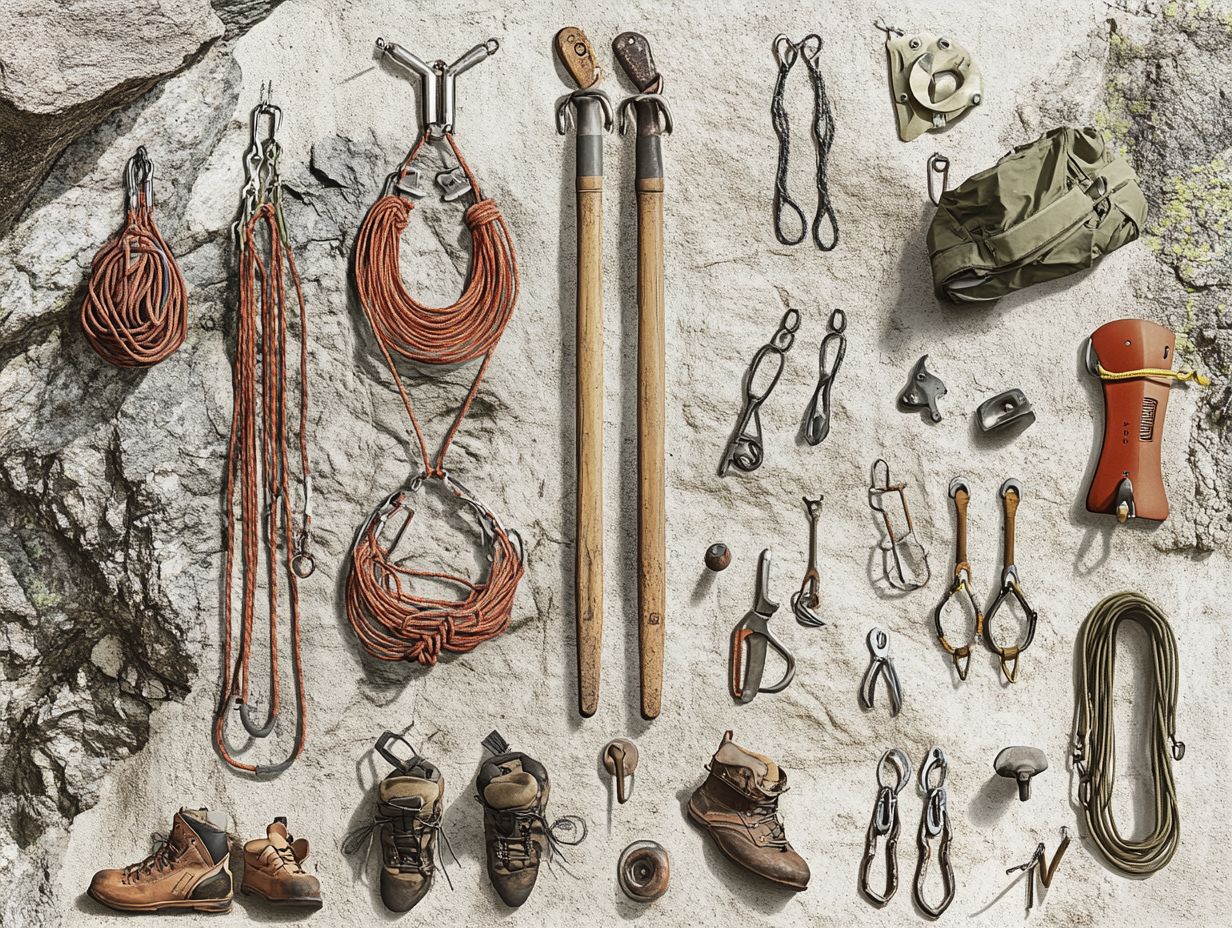
The evolution of climbing equipment showcases an impressive journey marked by technological advancements and innovations that have greatly improved your safety and performance as a climber.
What began as simple tools has transformed into a sophisticated landscape of climbing gear, thanks to high-quality materials like dynamic ropes and cutting-edge climbing protection systems.
These improvements arose from the pressing need for increased safety, efficiency, and adaptability across diverse climbing environments.
Advancements in Design and Technology
Advancements in design and technology have transformed climbing gear. Innovations like aluminum carabiners and specialized climbing packs elevate both safety and performance. These developments enable you to tackle challenging routes with confidence, as modern gear is crafted to be lighter, stronger, and more durable than ever before.
Improvements in harness design, featuring adjustable leg loops and gear loops, enhance comfort and accessibility, making it easy to manage your equipment. The introduction of dynamic ropes with a lower impact force ensures reduced falls, boosting your safety and providing peace of mind during tough ascents.
Advances in digital technology, like GPS devices and mobile apps designed for climbing, greatly improve your route planning and navigation. This allows you to focus more on honing your skills and enjoying the experience rather than getting bogged down by logistics.
These innovations not only elevate your performance but also create a more enjoyable and safer climbing environment.
Modern Climbing Equipment
Modern climbing equipment represents a sophisticated blend of safety and gear that helps you climb better, meticulously crafted to cater to the diverse needs of today s climbers. This extensive range encompasses specialized items like climbing shoes, safety harnesses, and a variety of climbing accessories, each tailored for different climbing styles be it sport, trad, or bouldering.
Every piece of equipment plays a crucial role in optimizing your climbing performance while ensuring your safety throughout the ascent.
Types of Equipment and Their Uses
There s a wealth of climbing equipment available today, each designed with a specific purpose in mind, enhancing your climbing techniques in unique ways. Essential items include quickdraws to connect climbing protection to your rope, dynamic ropes that absorb falls, and various types of climbing protection that secure you as you ascend.
You’ll rely on harnesses to comfortably distribute your weight and ensure your safety during climbs. Carabiners, those versatile connectors made from aluminum or steel, are essential for linking gear and facilitating seamless transitions between different climbing setups.
Belay devices manage rope tension, allowing for controlled descents and secure catches during a fall. And let s not forget chalk bags they help keep your hands dry for a better grip, optimizing your performance on challenging routes.
Each piece of equipment enhances your safety and adapts to your climbing style, whether you re into sport, trad, or bouldering. How cool is that?
Notable Climbing Equipment Innovations
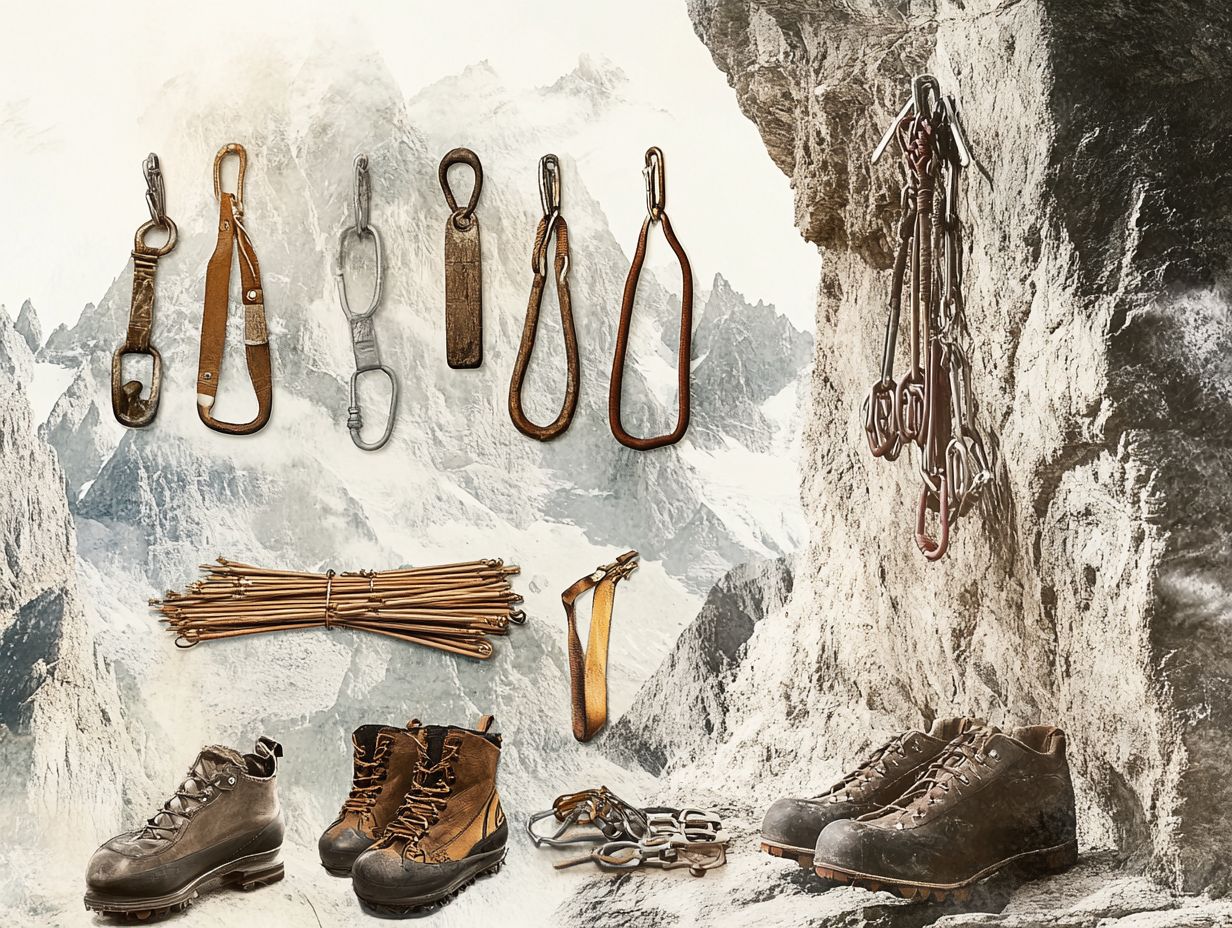
Notable innovations in climbing equipment have transformed the landscape of gear, demonstrating a commitment to safety and performance.
Visionaries like Yvon Chouinard have led the way with groundbreaking technologies, such as clean climbing techniques, which emphasize reducing environmental impact while safeguarding climbers.
This pioneering spirit has shaped the evolution of modern climbing equipment, ensuring that both safety and sustainability remain at the forefront of the climbing experience.
Ready to elevate your climbing experience? Check out our latest gear collection!
Revolutionary Designs and Impact on the Sport
Revolutionary designs in climbing gear have transformed the sport, elevating safety and enhancing climbing performance. Innovations like Boreal climbing shoes and Chrome-Moly carabiners show how advancements in materials and design have redefined climbing, allowing for greater efficiency and security on challenging routes.
Take the introduction of lightweight, durable materials in footwear. These innovations provide better grip and precision, essential for tackling tricky footholds and ensuring stability on precarious ledges.
Advancements in carabiner design, including automatic locking mechanisms, have raised safety standards by minimizing the risk of accidental openings.
These developments cater not only to seasoned climbers pushing their limits but also enable beginners to build confidence, fostering a more inclusive climbing community. Each innovation stands as a testament to how thoughtful engineering can elevate both individual performance and collective safety in climbing.
Future of Climbing Equipment
Exciting advancements are on the horizon for climbing equipment! As technology progresses, you can anticipate innovations that incorporate smart materials and enhanced safety features, potentially transforming interactions with your gear and the surrounding environment.
Predictions and Potential Developments
Predictions for the future of climbing equipment indicate a promising trajectory, emphasizing innovations that prioritize safety and performance enhancements. Expect developments like advanced dynamic ropes, which stretch to absorb shock, and state-of-the-art climbing protection as technology progresses, enabling you to tackle formidable routes with confidence.
In this rapidly evolving landscape, advancements may introduce intelligent gear equipped with sensors that deliver real-time data on environmental conditions and climbing performance. This technology could change the way you assess risks and refine strategies across diverse terrains.
Innovations like lightweight, breathable harness materials and more durable quickdraws promise to enhance comfort while reducing fatigue during longer ascents. As these enhancements come to fruition, you’ll be better equipped to push your limits while minimizing the inherent risks of the sport, nurturing a culture of safer exploration.
Frequently Asked Questions
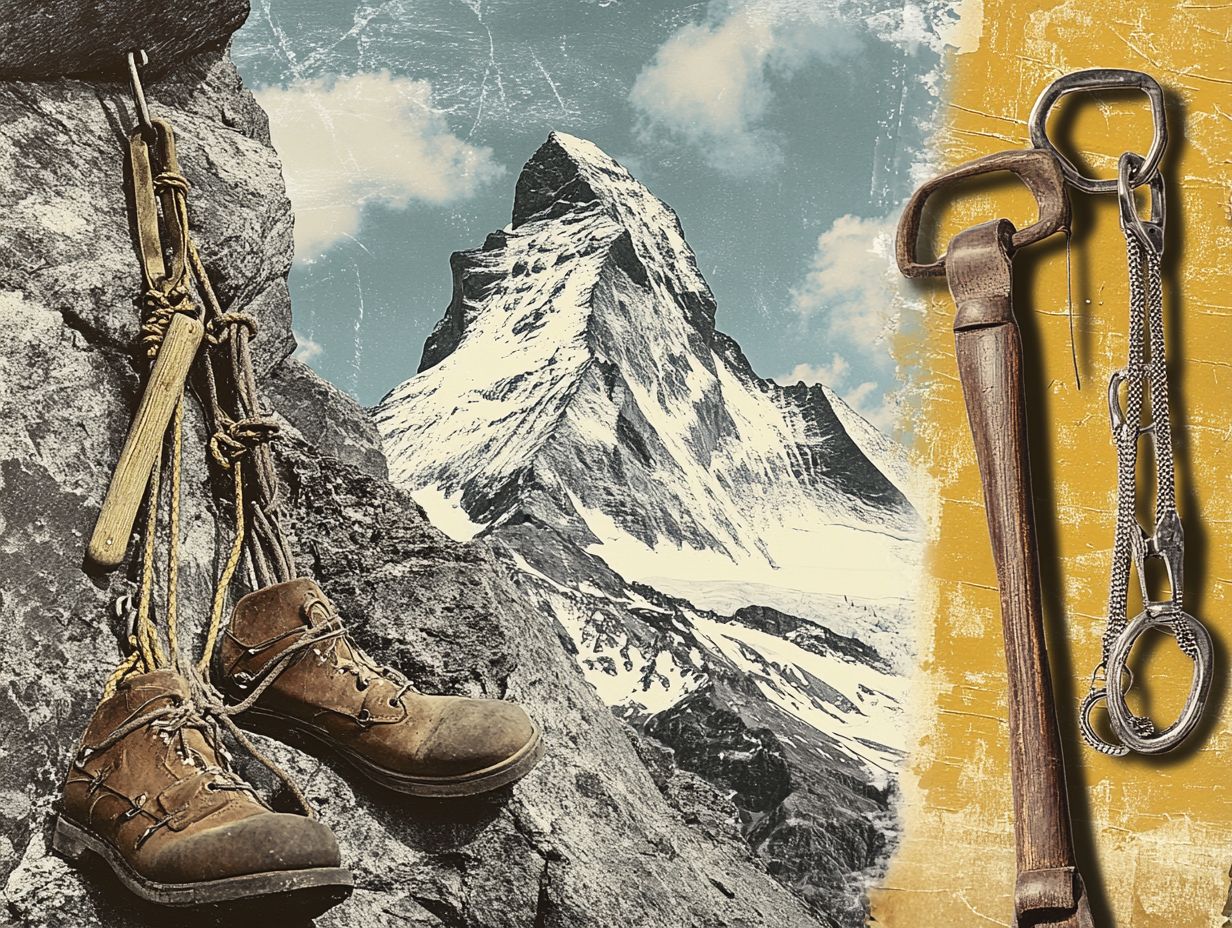
What is the history of climbing equipment?
The history of climbing equipment can be traced back to the early 19th century when mountaineering became popular in Europe. Climbers used rudimentary gear like ropes, wooden poles, and leather boots.
When did climbing equipment start to evolve?
The evolution of climbing equipment began in the 20th century with the invention of the metal piton and carabiner. These innovations revolutionized climbing and allowed for more challenging ascents.
What role did World War II play in the development of climbing equipment?
During World War II, rappelling techniques in military training led to the development of modern harnesses and ropes for climbers. This period also saw the introduction of aluminum pitons and ice axes.
What were some key advancements in climbing equipment during the 1950s and 1960s?
The 1950s and 1960s saw the introduction of nylon ropes, which were stronger and more durable than traditional hemp ropes. Climbers also began using crampons and ice screws, allowing them to tackle technical and icy terrain.
How did the sport of climbing impact the development of equipment?
As climbing became more popular and challenging routes were explored, gear manufacturers focused on creating specialized equipment for different types of climbing, such as rock, ice, and alpine.
What are some notable improvements in climbing equipment in recent years?
In recent years, climbing equipment has become lighter, stronger, and more efficient.
This includes ultralight harnesses, lightweight helmets, and advanced safety gear. There is also a growing use of eco-friendly and sustainable materials in climbing gear. These improvements make climbing safer and more enjoyable for everyone, from beginners to seasoned pros!

